False-positives and fear
Research has once again shown that false-positive screening mammography results lead to increased anxiety for the women that receive them, and that these feelings can last for months. But how much should we fear the fear itself?
The question comes up in discussions of mammography screening intervals as the harms of any screening program must weighed against the benefits. If a false-positive scan could result in persistent psychosocial distress, that’s something that should be accounted for.
The latest study to look at the emotional consequences of a false-positive screening mammogram was published this week in Cancer Epidemiology, Biomarkers & Prevention, a journal of the American Association for Cancer Research.
Swedish researchers, including Anetta Bolejko, PhD, in the Department of Medical Imaging and Physiology at Skåne University Hospital, looked at the results of questionnaires given to nearly 400 women who were recalled for abnormal mammography, but no breast cancer was subsequently found. Most were understandably distressed at the initial results: 88 percent reported feeling uneasy, sad or unable to cope. Many had difficulty sleeping.
These feeling persisted in some women for months. A year after first receiving the screening result, even after being considered free of cancer, women who received a false-positive were more than twice as likely to report psychosocial consequences.
The good news is that, similar to previous studies, these feeling of anxiety appear to wane over time. Initial questionnaire responses indicated a fivefold higher rate of psychosocial consequences soon after receiving the false-positive, while this rate had dropped after six months.
A 2013 study published in Annals of Family Medicine and another in 2014 from JAMA Internal Medicine both found initially elevated levels of anxiety in women receiving a false-positive, but the differences in psychosocial outcomes between them and those receiving normal mammography results generally mitigated over time.
In a joint statement following the publication of the 2014 JAMA Internal Medicine study, the American College of Radiology and Society of Breast Imaging wrote that the research “proves that patients experience short term anxiety regarding test results and that these feelings rapidly decline over time. The study also shows that there are no measurable effects to women’s health from experiencing a false-positive exam as some have previously claimed.”
Professionals should seek out which women may need additional assistance following initially inconclusive results, the ACR and SBI added. Here again the findings of Bolejko et al. this week could prove illuminating. The study found early recall, being foreign-born, lacking social support and dissatisfaction with information at the diagnostic work-up were all predictors of psychosocial consequences.
Additional support and educational resources should be available that cater to those who will need them at a time of distress. Reports of transient feelings of anxiety following a false-positive shouldn’t derail a screening mammography program, but they can point to opportunities for improvement in the care patients receive.
-Evan Godt
Editor – Health Imaging

